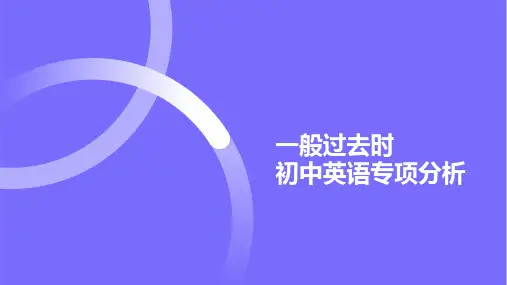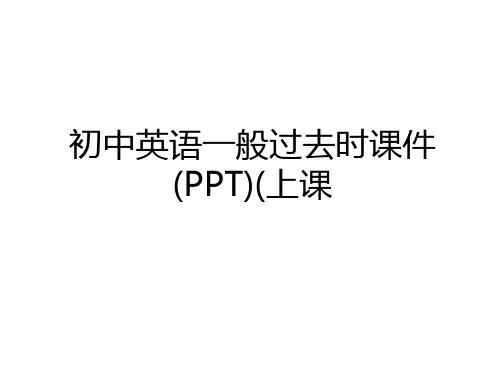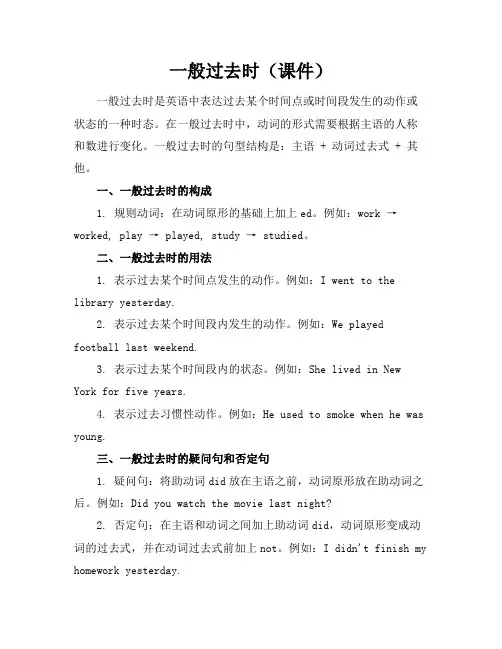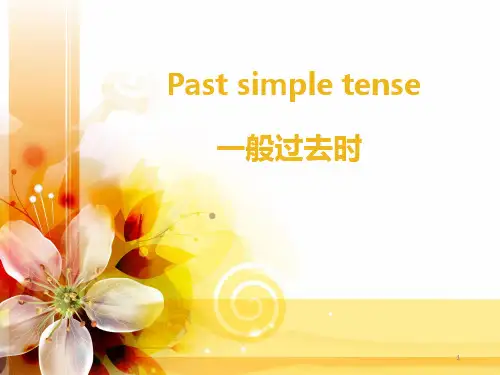初中讲一般过去时课件(PPT)讲课教案
一般过去时(12张PPT)初中英语专项复习课件

一般过去时 初中英语专项分析
一般现在时 de 应用场景
过
动作行为
去
发
生
曾经
的
存在的状态
识别 标志词 理解 句意
答题技巧
熟练 动词 转换
yesterday last week 3 days ago
动词 过去式
熟练 句型 转换
肯定 否定 疑问
一般 过去时 He played basketball yesterday.
yesterday? Yes, I did. No, I didn’t.
动词 过去式 形态的变化
一般
直接加 ed
二般
以 e 结尾,去 e 加 ed live dance hope use
动词 过去式 形态的变化
三般
重读辅元辅,双写尾字母
stop plan
四般
辅音字母 + y 结尾,把 y 变 i 加 ed cry study worry
标志词
时间状语:last night, yesterday, the day before yesterday last week, some years ago in 1995, the other day, just now, in the past
最新初中英语一般过去时课件(PPT)(上课教学文案

他每天都吃水果。
He __h_as__ fruit every day.
昨天他吃了3个苹果。
He _h_a_d__ 3 apples yesterday.
have反复发生的动作。 My father often went to work by bus last year. When I was a child, I often listened to music.
2.表示过去经常或反复发生的动作, 常与often,always等表示频度的 间状语连用:
初中英语一般过去时课件 (PPT)(上课
什么是一般过去时?
一般过去时表示过去某个时间发生的动 作或存在的状态。常和表示过去的时间 连用。如:last year, yesterday等.
我每天去上学。 我昨天去上学。 他每天下午都去打篮球。 他上星期一打篮球。
• I went to school yesterday.
I get up at 6:30 every morning. I _g_ot_ up at 9:00 last Sunday. He plays football every afternoon. He _pl_a_y_ed_ basketball yesterday afternoon.
动词原形、第三人称单数 动词过去式
I often got up very early at that time.
3.表示已故人所做的事情。
Comrade Lei Feng did good deeds in his life. 雷锋同志做了一生的好事。
一般过去时(课件)

一般过去时(课件)一般过去时是英语中表达过去某个时间点或时间段发生的动作或状态的一种时态。
在一般过去时中,动词的形式需要根据主语的人称和数进行变化。
一般过去时的句型结构是:主语 + 动词过去式 + 其他。
一、一般过去时的构成1. 规则动词:在动词原形的基础上加上ed。
例如:work → worked, play → played, study → studied。
二、一般过去时的用法1. 表示过去某个时间点发生的动作。
例如:I went to the library yesterday.2. 表示过去某个时间段内发生的动作。
例如:We playedfootball last weekend.3. 表示过去某个时间段内的状态。
例如:She lived in New York for five years.4. 表示过去习惯性动作。
例如:He used to smoke when he was young.三、一般过去时的疑问句和否定句1. 疑问句:将助动词did放在主语之前,动词原形放在助动词之后。
例如:Did you watch the movie last night?2. 否定句:在主语和动词之间加上助动词did,动词原形变成动词的过去式,并在动词过去式前加上not。
例如:I didn't finish my homework yesterday.四、一般过去时的特殊用法1. 过去进行时:表示过去某个时间点正在进行的动作。
例如:What were you doing at 8 o'clock last night?2. 过去完成时:表示在过去某个时间点之前已经完成的动作。
例如:I had finished my work before he came.3. 过去完成进行时:表示在过去某个时间点之前一直在进行的动作。
例如:She had been waiting for two hours when he finally arrived.一般过去时(课件)一般过去时是英语中表达过去某个时间点或时间段发生的动作或状态的一种时态。
一般过去时说课ppt课件

No,we/you were not. No,we were not. No,they were not.
Did I work? Yes,you did. No,you did not. work Did we work? Yes,we/you did. No,we/you did not.
Did you work? Yes,I did. No, I did not.
4. ______ you _______ (visit) your relatives last Spring Festival?
5. ______ he _______ (fly) a kite on Sunday? Yes, he ______.
6. Gao Shan _______ (pull) up carrots last National Day holiday.
9
Step 2. General introduction
• 定义:一般过去时态表示过去某个时间发生的动作或存
定义 在的状态,常和表示过去的时间状语连用。
• 过去时间里发生的动作或状态。
用法 • 过去经常或反复发生的动作。
• 规则动词后加 –ed 或 -d。
构成 • 不规则动词过去式需注逐一熟记。
难点 • 学生灵活运用所学知识 准确流畅的与他人交流 6
教法与学法
教法
任务教 学法
交际教 学法
学法
参与 探究 交流 合作
7
Stage 5 教学设计及过程 1.Lead-in(3’)
2.Introduction of the tense(3’) 3.The changes of verbs(14’) 4.Different sentence structures(4’) 5. Time for students to practice(14’)
初中讲一般过去时课件(PPT)

谓语构成
一般过去时的谓语构成:由动词 的过去式构成
规则变化
1.一般加ed work — worked 2.以e结尾加d change — changed 3.末尾只有一个辅音字母的重读闭 音节词,先双写这个辅音字母,再 加ed . stop — stopped
prefer — preferred
4.以辅音字母加y 结尾的词,先 改 y为 i,再加ed
【误】I visited the Palace Museum. (在没有上下文的情况下,应避免这样 说) 【正】I visited the Palace Museum last year. 去年我参观过故宫博物院。 【正】I have visited the Palace Museum.
2.表示过去经常或反复发生的动作和存在的状 态,常与often,always等表示频度的时间状语 连用:
写出下列动词的过去式
1. look 2. live 3. stop 4. hope 5. trip 6. call 7. eat 8. want 9. Say 10.See 11.put
12.read 13.take 14.buy 15. Sing 16. Hear 17. Make 18. Find 19.break 20.Think 21.fall 22.write
6.其他时间状语:
一般过去时的讲解ppt课件完整版

助动词did的用法
在一般过去时中,助 动词“did”用于构 成疑问句和否定句。
在回答一般过去时的 疑问句时,可以用 “did”的相应形式 进行回答。
“did”后面跟动词 原形,表示过去某个 时间发生的动作或状 态。
一般过去时的否定句和疑问句
否定句
在动词前加“didn’t”,后面跟动词原形,表示过去某个时间没有发生的动 作或状态。例如:“I didn’t go to the park yesterday.”(昨天我没有去公 园。)
陈述句改疑问句
指导学生将一般过去时的 陈述句改写为疑问句,注 意语序的调整和助动词 did的使用。
特殊疑问句的回答
给出特殊疑问句及其回答 ,让学生熟悉一般过去时 特殊疑问句的构成和回答 方式。
阅读理解中一般过去时的识别与运用
阅读文章并回答问题
提供一篇含有一般过去时的文章,让学生阅读后回答与文章内容 相关的问题。
疑问句
将助动词“did”放在主语前构成疑问句,表示询问过去某个时间是否发生了某 个动作或状态。例如:“Did you go to the park yesterday?”(昨天你去公 园了吗?)
04
一般过去时的重点与难点
BIG DATA EMPOWERS TO CREATE A NEW
ERA
不规则动词的过去式
识别一般过去时的标志词
列出一般过去时的常见标志词,如yesterday, last week等,让学 生在阅读过程中识别并标注出来。
运用一般过去时描述事件
要求学生运用一般过去时描述一个发生在过去的事件,注意动词过 去式的正确使用和句子结构的完整性。
THANKS
感谢观看
1 2
初中英语-一般过去时-教学完整ppt课件
完整版PPT课件
14
05
句型
完整版PPT课件
15
否定句
在动词过去式前+ didn’t, 再把动词变回原形。如: I didn’t wgeont to school by bus yesterday.
在动词为be的一般过去时句子中,在 was/were 后面+ not 如: They were not happy last night.
完整版PPT课件
6
一般过去时结构
主语+动词过去式+其他+(时间状语) 例句:He read a book yesterday.
完整版PPT课件
7
变形
1. 一般在词尾直接+ed,如:play---played 2. 以不发音的 e 结尾的动词,词尾+ -d,如:live---lived 3. 以辅音字母 y 结尾的动词,把 -y 变成 -i ,再加 –ed,
Too. I am busy but happy on the weekend.
完整版PPT课件
13
Last Weekend I g_o_t_u_p_(get up) early last weekend. Then I _p_l_a_y_e_d (play) sports. I _h_ad_(have) milk and bread for breakfast. On Saturday morning, I _r_ea_d_ (read) some books and w__a_tc_h_ed(watch) TV. In the afternoon, Id_i_d_(do) housework. I c_o_o_k_e_d(cook) dinner for my family in the evening. On Sunday, I w__e_nt (go) shopping with my friends. I c_le_a_n_e_d (clean) my room, too. I w__a_s (am) busy but happy on the weekend.
初中英语-一般过去时-教学课件
单击此处添加副标题
汇报人:
目录
添加目录项标题 一般过去时的定义与用法 一般过去时的句型与表达 方式 练习与巩固
课件封面与目录 一般过去时的构成 一般过去时的特殊用法
01
添加章节标题
02
课件封面与目录
课件标题
课件封面:标 题“初中英语一般过去时-教
学课件”
课件目录:介 绍课件的主要
定义:在某些情况下当上下文已经明确表明动作发生在过去可以省略句中的主语和 谓语只保留时间状语。
用法:通常用于口语和非正式书面语中以避免重复和冗余。
示例:昨天我和他见面了(Yesterdy, I met him.)。在这个句子中“I met him”可以省 略为“Yesterdy”。
注意:在正式书面语中建议避免使用这种用法以保持句子结构的完整性和清晰度。
谓语动词用ws/were
谓语动词用did
谓语动词用ws/were+动词不 定式
谓语动词用did+动词不定式
05
一般过去时的句型 与表达方式
表示过去的动作和状态
句型:一般过去时的基本句型是"主语+谓语+其他"表示过去的某个动作 或状态。
时态标志:一般过去时的谓语动词需要使用过去时态如ws、were、did 等。
以及复数 (we/you/the
y)
动词hve的一般过去时形式
构成:动词hve的 一般过去时形式 为“hd+过去分 词”
用法:表示过去 某个时间点发生 的动作或存在的 状态
示例:I hd book in my hnd. (我手里拿 着一本书。)
注意:与现在完 成时态的区别
一般过去时讲解PPT课件
did
助动词,用于构成一般过去时的 疑问句和否定句。
主语
句子中的动作执行者,可以是名 词、代词等。
例如
What did you do yesterday? 你 昨天做了什么?
其他成分
包括宾语、状语等,根据句子需 要而定。
动词原形
指动词的基本形式,即不加任何 时态或语态标记的形式。
特殊疑问句实例分析
when、after、 before、as等引导的 表示过去的时间状语 从句。
已经、曾经、刚才、 那时等表示过去的时 间副词。
02
一般过去时肯定句结构
主语+动词过去式+其他成分
01
02
03
主语
句子中的主体,可以是人 、物或抽象概念。
动词过去式
表示过去某个时间里发生 的动作或状态。动词的过 去式可分为规则变化和不 规则变化两种。
表示过去某个时间里发生的动 作或状态。
用法
陈述过去的事实或情况,描述 过去经常或反复发生的动作。
现在完成时
表示过去发生的动作对现在造 成的影响或结果,或从过去已 经开始,持续到现在的动作或 状态。
用法
强调过去与现在的联系,表达 一个动作从过去一直延续到现
在。
两者在时间状语上的区别
01
02
03
04
一般过去时
一般过去时讲解PPT课件
目录 Contents
• 一般过去时基本概念 • 一般过去时肯定句结构 • 一般过去时否定句结构 • 一般过去时疑问句结构 • 一般过去时特殊疑问句结构 • 一般过去时与现在完成时的比较
01
一般过去时基本概念
定义与作用
定义
一般过去时表示过去某个时间里 发生的动作或状态。
一般过去时(复习)公开课PPT课件
以辅音字母+y结尾的动词,把y变为i 再加-ed,如:study—studied。
以不发音的e结尾的动词,动词词尾 加-d,如:live—lived。
以一个辅音字母结尾的重读闭音节动 词,双写词尾辅音字母,再加-ed, 如:stop—stopped。
创造英语环境
在日常生活中尽量使用英 语,提高英语的实际运用 能力。
鼓励学生在日常生活中运用一般过去时
记录日常活动
用英语记录自己一天的活 动,使用一般过去时描述 过去发生的事情。
讲述经历
和同学或家人分享自己的 经历,使用一般过去时讲 述故事。
看图说话
选择一张图片,使用一般 过去时描述图片中的人物 和事件。
通过给出句子和选项,让学生选择正确的动词过去式完成句子。
改写句子
提供现在时的句子,要求学生将其改写为一般过去时。
连词成句
给出打乱顺序的单词,让学生重新排列并加上适当的标点符号,形 成语法正确、意思完整的句子。
小组讨论并分享经验
分组讨论
学生分组,每组围绕一个与一般过去时相关的话题展开讨论,如“你昨天做了什 么?”或“你曾经去过哪些地方?”。
常见误区及注意事项
不规则动词的过去式需要特殊记忆,不能简单地加-ed,如:go—went, eat—ate等。
在使用一般过去时时,要注意动词的过去式与过去分词的区分,避免混 淆。
在表达过去发生的动作时,要注意时间状语的正确使用,确保时态的一 致性。
03
一般过去时在句子中运用
陈述句中使用一般过去时
讲解一般过去时在各种句式中的 表达方式,如肯定句、否定句、 疑问句等,并给出相应的例句。
- 1、下载文档前请自行甄别文档内容的完整性,平台不提供额外的编辑、内容补充、找答案等附加服务。
- 2、"仅部分预览"的文档,不可在线预览部分如存在完整性等问题,可反馈申请退款(可完整预览的文档不适用该条件!)。
- 3、如文档侵犯您的权益,请联系客服反馈,我们会尽快为您处理(人工客服工作时间:9:00-18:30)。
昨天他吃了3个苹果。
He _h_a_d__ 3 apples yesterday.
have/ has
had
I get up at 6:30 every morning. I _g_ot_ up at 9:00 last Sunday.
He plays football every afternoon. He _pl_a_y_ed_ basketball yesterday afternoon.
used up. 发动机因燃料用光而停机了。 注意:
在一般过去时的句子中,通常都要有表示 过去的时间状语。
【误】I visited the Palace Museum. (在没有上下文的情况下,应避免这样
说)
【正】I visited the Palace Museum last year.
去年我参观过故宫博物院。
他现在在北京。 He __is__ in Beijing now. 他昨天在上海。 He _w_a_s_ in Shanghai yesterday.
他们今天在中国。 They _a_r_e_ in China today.
他们昨天在日本。 They _w_e_re_ in Japan yesterday.
finished /t/ enjoyed /d/ shouted /Id/ moved /d/
helped /t/ wanted /Id/ called /d/ needed /Id/
1. 一般过去时的构成
一般过去时是用动词的过去式来表示。
His words fetched a laugh from all present.
She doesn’t play basketball after school.
She _d_id_n_’t__pl_a_y_ basketball after school yesterday.
Do you go to school on foot every day? _D_id_ you _g_o to school on foot yesterday.
【正】I have visited the Palace Museum.
2.表示过去经常或反复发生的动作和存在的状 态,常与often,always等表示频度的时间状语 连用:
I often got up very early at that time.
I wrote home once a week at college. 我上大学时每周给家里写一封信。 He was already in the habit of reading widely in his boyhood. 他童年时就养成了广泛阅读的习惯。
Does he go to school by bus every day?
_D_id_ he _g_o_to school by bus yesterday?
don’t/ doesn’t
didn’t
do/ does
did
谓语构成
1.动词 be
was , were
2.动词 have, has had
He does his homework every evening.
He _d_i_d_ some reading last night.
动词原形、第三人称单数 动词过去式
They don’t watch TV in the evening. They _di_d_n_’t_w__at_c_h TV last night.
3.末尾只有一个辅音字母的重读闭 音节词,先双写这个辅音字母,再 加ed . stop — stopped
prefer — preferred
4.以辅音字母加y 结尾的词,先 改 y为 i,再加ed
study — studied
5.不规则变化.(见不规则动词表P102)
规则动词过去式-ed的发音
1.在以清辅音结尾的规则动词后,
-ed读作/ t / worked
/w3:k/t/
2.在以浊辅音或原音结尾的规则动词后,
-ed读作/d /
lived /lIv d//
play ed /pleI d//
3.在以/t/或/d/结尾的规则动词后,
-ed读作/Id /
visit ed /’vIzIt I/d/
初中讲一般过去时课件(PPT)
什么是一般过去时?
动词的一般过去时态表示过去发生的 动作、情况或存在的状态。
行为动词(即实义动词)的过去式没有人称 和数的变化。
Please look at the sentences
我今年12岁. I _a_m_ 12 years old this year.
我去年11岁. I _w_a_s_ 11 years old last year.
他的话使在场的人都笑了。
I did not sleep well last night. 我昨晚没睡好。
Did you direct the tourist to the hotel? 你告诉这位游客去旅馆的路了吗?
用法
1.表示过去某个特定时间发生的动作或存在的状态 He suddenly fell ill yesterday. 昨天他突然生病了。 The engine stopped because the fuel was
3.助动词do, does did
4.行为动词用过式
一般过去时以动词的过去式来表示,
没有人称和数的变化.(was,were除外)
I went to school yesterday.
They went to school yesterday.
一般过去时的谓语构成:由动词 的过去式构成
规则变化
1.一般加ed work — worked 2.以e结尾加d change — changed
am/ is are
was were
每天,早餐我吃鸡蛋和牛奶。 I h_a_v_e_ eggs and milk for breakfast every morning.
昨天,早餐我吃面条。 I _h_a_d_ noodles for breakfast yesterday morning.
他每天都吃水果。
